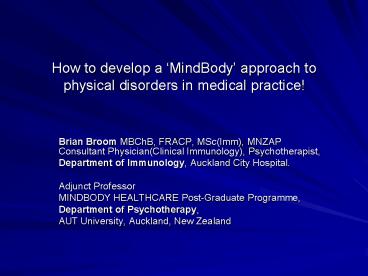How to develop a - PowerPoint PPT Presentation
1 / 28
Title:
How to develop a
Description:
(Harry Stack Sullivan--quoted by E. Levenson). Nothing certain can be said about the nature of truth, except perhaps that it is what our peers will let us away ... – PowerPoint PPT presentation
Number of Views:142
Avg rating:3.0/5.0
Title: How to develop a
1
How to develop a MindBody approach to physical
disorders in medical practice!
- Brian Broom MBChB, FRACP, MSc(Imm),
MNZAPConsultant Physician(Clinical Immunology),
Psychotherapist, - Department of Immunology, Auckland City Hospital.
- Adjunct Professor
- MINDBODY HEALTHCARE Post-Graduate Programme,
- Department of Psychotherapy,
- AUT University, Auckland, New Zealand
2
If we desire to be effective as whole person
clinicians there are only three issues!
- Paradigm
- Attitudes and Skills
- The Clinical Framework
3
- Meaning-full disease How personal experience and
meanings initiate and maintain physical illness.
- B C Broom (2007) Karnac Books, London
- Somatic Illness and the patients other story. A
practical integrative approach to disease for
doctors and psychotherapists. - B C Broom (1997) Free Association Books,
- New York/London
- Symbolic Disorders and MindBody Co-Emergence. A
challenge for psychoneuroimmunology. - Broom, B., Booth, R., and Schubert, C.
- EXPLORE Journal of Science and Healing (IN
PRESS)
4
A case of idiopathic ANGIOEDEMA
5
Clinical Paradigm
6
In my clinical framework
- Personhood
- Clinically
- People are unitive
- Body and mind, physicality and subjectivity are
not divided - Body and mind co-emerge SL3
- Personhood core concept
- Avoid medical dualism SL1
- Avoid the either/or, body or mind default
position - Avoid default linearity i.e. body first, then
mind - Diagnosis is a role-related activity based on a
certain way of seeing SL1 - We can have the diagnosis but not have the
story - Diagnosis takes its place within a wider view of
the person - Think person, think story, think diagnosis
7
Co-emergence
- Assumes unbroken continuity between internal body
processes and external interpersonal meanings and
influences, - Asserts that disease-related 'internal' bodily
changes and collateral external interpersonal
and environmental fluxes are mutually contingent
and crucial to the development of the disease. - Offers an expanded PNI and medical framework
8
Co-emergence of
- Physicality and subjectivity
- Body and mind
- Body and story
- Illness/disease and symbol
- Illness/disease and meaning
- Illness/disease and story
9
Medical dualism
- the widespread assumption in Western healthcare
that physical diseases (in particular) can be
worked with therapeutically without much
attention paid to mind (subjectivity) factors
i.e. that mind and body are in essence or
functionally separated in some way such that mind
factors may be ignored.
10
What is a DIAGNOSIS?
- An observed pattern of dysfunction, recognized by
a group of people who look at patients and
dysfunction in the same way, and in a way that
enables them to use agreed upon therapies, which
are based on that same way of looking.
11
In practice what does this mean?
12
Every medical behaviour flows from clinicians
paradigm-the first hurdle to a mindbody
practice
- The first big hurdle is paradigm
- What you say, how you introduce mind, how you
educate, when you educate - We Drs are more the problem than the patients
- Patients greatly prefer being treated as persons
rather than diagnostic objects (they want
diagnosis as well!) - Residual dualism
- All disease is multidimensional and
multifactorial - Disease is a dysfunction in a whole person
(system) - The patients story is always importantin some
way - Physicality and subjectivity up front together
13
What does this mean in practice?New
patients-beginning issues
- the pre-emptive strike
- declare up front that illness and disease occur
in a person, not just in a body separated off
from the rest of them. - I am interested in the whole of them, and I will
be asking questions about the whole of them - we get unwell for both visible and not so visible
reasons - transference or baggage from previous
encounters nutter, hypochondriac, making it up,
not real - hope/investigation/normal/pushed away
14
Attitudes and skills
- the fix-it mode versus the listening/empathy
mode - suspending focus, expanding marginal capacity
- accurate recognition and reflection of story
- honoring the little (you are seeing what is
already) - educating about paradigm
- stories, normalisation, universalisation,
self-revelation - the smorgasbord question
- prism metaphor
- comfortable with affective intimacy
- using specialists as contract investigators
- avoiding psychiatrisation
15
The Story in the Macro The Story in the
Micro (Exploring the Fault-lines) LISTENING VERY
CAREFULLY TO THE PATIENTS ACTUAL USE OF LANGUAGE
16
Believing in the Mind/Body Connections against
the Odds. Derailment Organic/functional
dichotomies Selfdoubt havent got the
skills Fear of medico-legal consequences Issues
of respect Humanistic waiting When will the
patient be ready?
17
Discovering the undeniable The Pursuit of the
Particular Must Go Slowly, and Expect to Find
what is Needed in the Little that is Given
18
(No Transcript)
19
Believing in the Mind/Body Connections against
the Odds. Adequate investigation The problem
specialist (overinvestigating/or nothing wrong
with you)
20
(No Transcript)
21
(No Transcript)
22
Symbolic Diseases
- Symbolic diseases (SDs) are defined as occurring
when the organ system involved, and/or the
pathological process, and/or the clinical
phenomenology, appears to be particularly
congruent with, or appropriate to, the patients
subjective meanings or story, as ascertained
from the patients language, life history, and
behaviours 4.
23
HELPING PATIENTS ACCEPT THE MIND/BODY CONNECTIONS
24
(No Transcript)
25
Auckland University of Technology Dept of
Psychotherapy
- Post-Graduate Program in MindBody Healthcare
- Diploma and Masters
- Part-time, block course-based, multidisciplinary,
open to clinicians of all kinds
26
(No Transcript)
27
(No Transcript)
28
(No Transcript)































